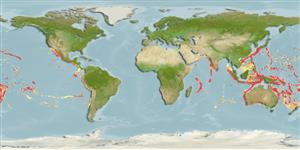Common names from other countries
Environment: milieu / climate zone / depth range / distribution range
Ecologia
Bentopelágico; intervalo de profundidade 200 - 1475 m (Ref. 96667). Deep-water; 33°N - 40°S, 54°E - 71°W
Indo-Pacific.
Length at first maturity / Tamanho / Peso / Idade
Maturity: Lm ? range ? - ? cm
Typically found near the sea floor in deep-seas. Its characteristic 3 pairs of extremely long, stilt-like pereiopods suggest its ability to walk on soft sediments. An opportunistic feeder, relying on phototrophically derived organic matter. Its feeding strategy may be assumed to be similar with its congener, N. exilis, a scavenger and predator that feeds mainly on fish remains and slow-moving benthic organisms. Shown to produce oval eggs (0.5 to 0.65 mm length) and may possibly achieve several reproductive outputs in its relatively long lifespan of 2 to 3 years (Ref. 97382).
Life cycle and mating behavior
Maturidade | Reprodução | Desova | Ovos | Fecundidade | Larvas
Members of the order Decapoda are mostly gonochoric. Mating behavior: Precopulatory courtship ritual is common (through olfactory and tactile cues); usually indirect sperm transfer.
Poupin, J. 1998. (Ref. 75706)
Status na Lista Vermelha da IUCN (Ref. 130435)
Status no CITES (Ref. 108899)
Not Evaluated
Not Evaluated
Uso pelos humanos
| FishSource |
Ferramentas
Mais informação
Idade/Tamanho
Crescimento
Comprimento-peso
Comprimento-comprimento
Morfologia
Larvas
Abundância
Fontes da internet
Estimates based on models
Preferred temperature
(Ref.
115969): 6 - 12.8, mean 8.3 (based on 423 cells).
Categoria de preço
Unknown.
